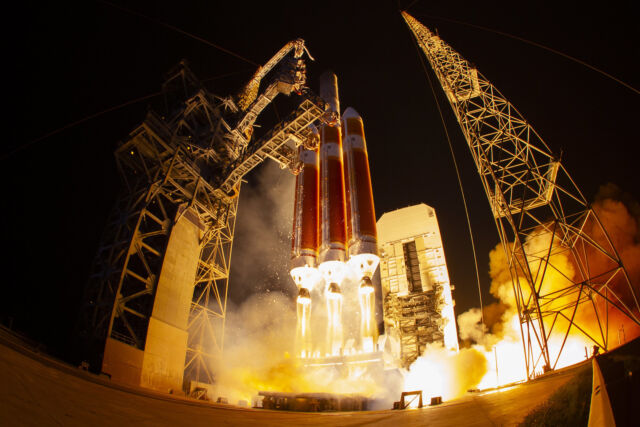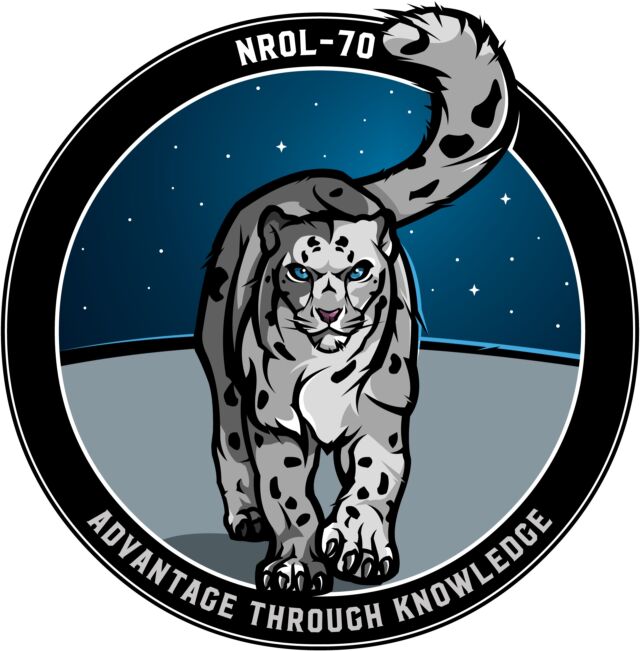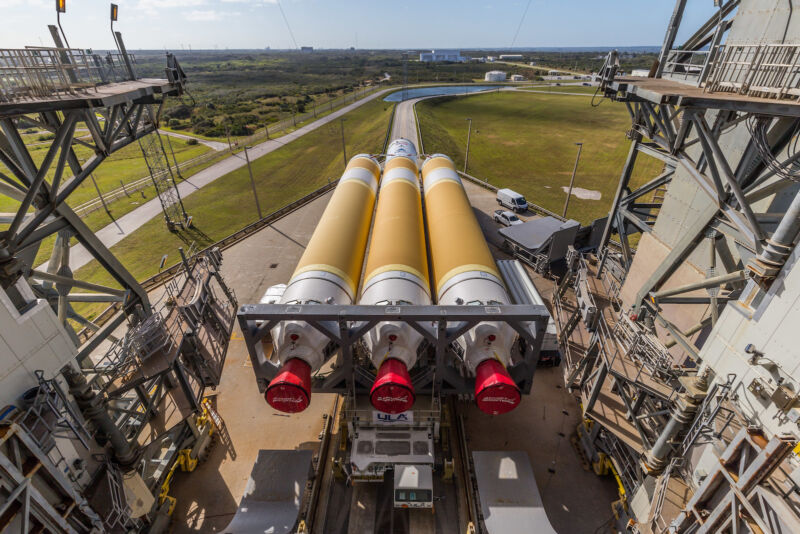The final Delta IV Heavy rocket is scheduled to launch Thursday, weather permitting.
This is the rocket that literally lights itself on fire before it heads to space. It's the world's largest rocket entirely fueled by liquid hydrogen, a propellant that is vexing to handle but rewarding in its efficiency.
The Delta IV Heavy was America's most powerful launch vehicle for nearly a decade and has been a cornerstone for the US military's space program for more than 20 years. It is also the world's most expensive commercially produced rocket, a fact driven not just by its outsized capability but also its complexity.
Now, United Launch Alliance's last Delta IV Heavy rocket is set to lift off Thursday from Cape Canaveral Space Force Station, Florida, with a classified payload for the National Reconnaissance Office, the US government's spy satellite agency.
"This is such an amazing piece of technology, 23 stories tall, a half-million gallons of propellant and a quarter-million pounds of thrust, and the most metal of all rockets, setting itself on fire before it goes to space," said Tory Bruno, ULA's president and CEO. "Retiring it is (key to) the future, moving to Vulcan, a less expensive higher-performance rocket. But it’s still sad.”
45th and final Delta IV
Weather permitting, the Delta IV Heavy will light up its three hydrogen-fueled RS-68A engines at 1:40 pm EDT (17:40 UTC) Thursday, the opening of a four-hour launch window. The three RS-68s will fire up in a staggered sequence, a permutation designed to minimize the hydrogen fireball that ignites around the base of the rocket during engine startup.
The Delta IV Heavy will certainly have a legacy of launching national security missions, along with NASA's Orion spacecraft on an orbital test flight in 2014 and NASA's Parker Solar Probe in 2018 on a mission to fly through the Sun's outer atmosphere.
But the fireball will leave an indelible mark in the memories of anyone who saw a Delta IV Heavy launch. It all comes down to the choice of super-cold liquid hydrogen as the fuel. The three RS-68 engines burn hydrogen along with liquid oxygen as the oxidizer.
"We like those propellants because they’re very, very high performance," Bruno said. "In order to prepare the RS-68 engines to get that very cold cryogenic propellant flowing through them, before they’re ignited, we start flowing that propellant.
"Hydrogen is lighter than air, so after it flows through the engine and into the flame trench, it then rises. When the engines are finally full and ready to go and we start spinning up the pumps, then we actually drop the main load (of propellant), we ignite it, and that flame carries on up that ... plume of hydrogen, which is clinging to the side of the booster and rising up.”
The Delta IV rocket cores are covered in orange foam insulation. One of the reasons for this is to protect the rocket from the fireball, leading to what Bruno called a "very dramatic effect of a self-immolating booster" that has the appearance of a "toasted marshmallow" as it heads to space.
A few seconds after the engines start, 12 hold-down bolts will blow to release the triple-core rocket from its restraints. More than 2 million pounds of thrust will power the Delta IV Heavy off the launch pad toward the east from Cape Canaveral. The RS-68 on the center core will throttle down to conserve liquid hydrogen and liquid hydrogen propellant, while the rocket's two side boosters will burn through their propellants in less than four minutes.
Once the Delta IV lets go of its side boosters and falls into the Atlantic Ocean, the center core throttles up and burns for another minute and a half. A few moments later, the first stage booster jettisons, and the upper stage's RL10 engine ignites for the first of three burns needed to propel the rocket's classified cargo into an orbit thousands of miles above Earth.
There's just a 30 percent chance of favorable weather for liftoff Thursday. High winds and cumulus clouds are the primary concerns. The weather forecast improves for a backup launch opportunity Friday afternoon.
You can watch the launch on ULA's live broadcast, embedded below.
This is also the final flight overall for the Delta rocket family—the 389th rocket with the Delta name—since 1960. But those earlier rockets share virtually nothing in common with the Delta IV, which debuted in 2002. The older generations of Delta rockets could trace at least some of their design lineage to the Thor program, a Cold War-era ballistic missile later converted into a satellite launcher.
The last of that older family of Delta rockets, the Delta II, launched for the final time in 2018. The Delta IV was a clean-sheet design, initially conceived by McDonnell Douglas, that won a contract from the Air Force in 1998, alongside Lockheed Martin's Atlas V rocket, to become the new workhorse launch vehicles for the military's fleet of satellites.
The Delta IV program became part of Boeing when that company merged with McDonnell Douglas in 1997. In 2006, Boeing merged its Delta rocket program with Lockheed Martin's Atlas V program, creating United Launch Alliance in a 50-50 joint venture.
The launch this week will mark the 45th flight of a Delta IV rocket and the 16th to fly in the Delta IV Heavy configuration. The Delta IV Heavy, in particular, launched the kinds of heavy military and intelligence-gathering satellites that once flew on the Titan IV rocket, which retired in 2005. These payloads have primarily included NRO eavesdropping satellites and the massive bus-size Keyhole imaging platforms, essentially Hubble-class telescopes pointed at Earth.
The Delta IV boasts a nearly perfect success record. The only blemish was on the first flight of the Delta IV Heavy in 2004 when a dummy payload was deployed into a lower-than-planned orbit after the three booster engines shut down a few seconds early.
But the Delta IV Heavy is expensive. At one time, a single launch on this expendable rocket cost as much as much as $400 million, although the government secured a somewhat lower price from ULA for buying in bulk the the final three missions on Delta IV Heavy. The Delta IV launched a commercial satellite on its first flight in 2002, but no more commercial customers ever bought a Delta IV launch.

The second-to-last Delta IV Heavy rocket launched in June 2023.
United Launch Alliance
The Delta IV launch pads in Florida and California were particularly complex, requiring maintenance and sustainment even during years-long lulls in launch activity.
These high prices helped open a path for SpaceX, then a newcomer to the national security launch business, to petition the Pentagon for the right to compete for military launch contracts. With its partially reusable Falcon 9 rocket, SpaceX offered lower prices than ULA. "I don't know how to build a $400 million rocket," Gwynne Shotwell, SpaceX's president and chief operating officer, told Congress in 2015.
The Falcon Heavy rocket debuted in 2018, giving SpaceX the capability to launch nearly all of the military's space missions. There are a few exceptions, like the NRO payloads assigned to the final few Delta IV Heavy rockets. SpaceX is developing a longer payload fairing for the Falcon Heavy to accommodate these types of satellites.
Now, ULA has the less expensive Vulcan rocket, which flew on a problem-free test flight in January. Vulcan will replace the Delta IV and Atlas V rockets in ULA's fleet. There are still 17 Atlas V rockets remaining in ULA's inventory, primarily missions to launch Boeing's Starliner crew capsule and Amazon's Kuiper broadband network.
Under a contract the Pentagon awarded in 2020, ULA's Vulcan rocket and SpaceX's Falcon 9 and Falcon Heavy will launch all of the military's most expensive and sensitive satellites over the next few years. In its heaviest configuration, the Vulcan will outlift the Delta IV Heavy without needing three first-stage boosters to do the job.
"Delta IV Heavy is three rockets bolted together," Bruno said. "With a single core Vulcan, we’re able to collapse that cost (of Delta IV Heavy) by 70 percent and make that mission a lot more practical."
SpaceX has an agreement with the Space Force to take over the former Delta IV launch pad at Vandenberg Space Force Base in California. Falcon 9 and Falcon Heavy rockets will launch from there. And SpaceX has its eye on Space Launch Complex-37 at Cape Canaveral, where the final Delta IV Heavy will take off this week, as a possible future home for the giant Starship rocket.
Launching a listening post
The NRO payload aboard the final Delta IV Heavy launch is likely a sophisticated reconnaissance satellite that will be stationed in geosynchronous orbit, more than 22,000 miles (nearly 36,000 kilometers) over the equator. At that altitude, the spacecraft will orbit Earth in lock-step with the planet's rotation and will operate near numerous satellites owned by US adversaries like China and Russia. This orbital regime is also populated with privately owned satellites, primarily providing communication services.
Experts can make an educated guess based on publicly available information on the trajectory of the Delta IV Heavy as it flies east from Cape Canaveral. Only the largest NRO spy satellites require a launch on a Delta IV Heavy, and the payload on this mission is "almost certainly" a type of satellite known publicly as an "Advanced Orion" or "Mentor" spacecraft, according to Marco Langbroek, an expert Dutch satellite tracker.
The Advanced Orion satellites require the combination of the Delta IV Heavy rocket’s lift capability, long-duration upper stage, and huge 65-foot-long (19.8-meter) trisector payload fairing, the largest payload enclosure of any operational rocket. In 2010, Bruce Carlson, then-director of the NRO, referred to the Advanced Orion platform as the "largest satellite in the world."
When viewed from Earth, these satellites shine with the brightness of an eighth-magnitude star, making them easily visible with small binoculars despite their distant orbits, according to Ted Molczan, a skywatcher who tracks satellite activity.

NRO mission patches are often an enigma. The patch for this mission, officially
codenamed NROL-70, features a snow leopard. "The snow leopard illustrates
the quiet strength with which we provide an advantage to the nation and its
allies," the NRO says.
National Reconnaissance Office
The final phase of the Delta IV Heavy launch sequence will play out over roughly six hours, enough time for the upper stage and its payload to coast up to geosynchronous altitude, where a final engine burn will circularize the orbit before satellite deployment.
"The satellites feature a very large parabolic unfoldable mesh antenna, with estimates of the size of this antenna ranging from 20 to 100 (!) meters," Langbroek writes on his website, citing information leaked by Edward Snowden.
The purpose of these Advanced Orion satellites is to listen in on communications and radio transmissions from US adversaries and perhaps allies. Six previous Delta IV Heavy missions also likely launched Advanced Orion or Mentor satellites, giving the NRO a global web of listening posts parked high above the planet.
The Advanced Orion-series satellites began launching on Titan IV rockets in 1995, following a pair of earlier NRO Orion payloads that launched in the 1980s on space shuttle missions. The NRO began using Delta IV Heavy rockets for the Advanced Orion missions in 2009 following retirement of the Titan IV.
Bruno, ULA's chief executive, said this is the kind of mission Delta IV Heavy, and now Vulcan, was made for.
"The national security space mission is our core," he said. "This is a unique set of missions that require this high-energy rocket capability, very special orbits. We designed Vulcan specifically for that. Every rocket can do a range of missions, but there’s one mission it's best at. It is literally designed to be the best at the mission we’re going to fly here with this last Delta IV."
When asked why not wait for a cheaper ride on Vulcan or Falcon Heavy, with its still-to-come longer fairing, Scolese said, "We had the spacecraft ready to go, and we had a rocket that we trust, so it made sense to continue on with this. Something has to be last and we’re proud to be on that vehicle, and we have a lot of confidence in the system."
Source



3175x175(CURRENT).thumb.jpg.b05acc060982b36f5891ba728e6d953c.jpg)


Recommended Comments
There are no comments to display.
Join the conversation
You can post now and register later. If you have an account, sign in now to post with your account.
Note: Your post will require moderator approval before it will be visible.